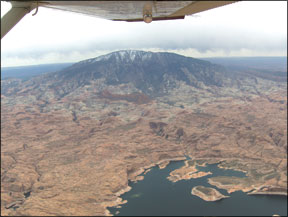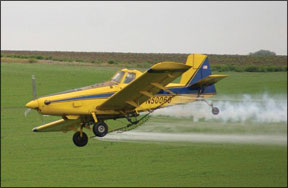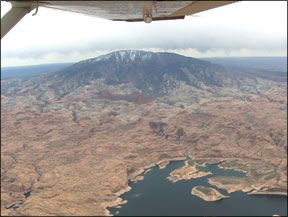Theres one undeniable constant in aviation: All accidents eventually terminate by contact with the surface of the planet. We have various ways of describing how that contact occurs, thus the somewhat oxymoronic phrase “controlled flight into terrain,” or CFIT. This category of accident is an attempt to explain the unexplainable: why pilots so often fly perfectly functioning airplanes into the ground, killing themselves and all aboard. However anomalous the concept, the occurrence of CFIT is 288 anything but. Pilots fly into the ground-terrain, trees, obstacles, water-nearly as often as they stall or lose basic control of the airplane. As we reported in our January 2010 article on the causes of fatal accidents, stalls lead the list, but CFIT is essentially tied for second, along with loss of control. In this article, well take a closer look at where the CFIT risks lie and how to avoid them. If it seems like this ought to be obvious knowledge, it apparently doesnt sink in with those who make the most fundamental errors in judgment with regard to flight near terrain or obstacles. Even high-time, professional pilots get sucked into the trap. Number Massage For our fatal accidents review, we examined 338 accidents in 2000 and 2008. In this article, were boring more deeply into the accident reports for a look at how and why CFITs occur. For our analysis, we sorted the accidents into our own sub-categories that the NTSB doesnt use. Furthermore, we had to make interpretations and definitions of our own. For our purposes, a CFIT is any accident in which it appears that the airplane was flown under control into the ground or obstacles. In other words, the pilot may or may not have been aware that he was at risk until a tree trunk or a pile of dirt came through the windshield. We didnt consider those accidents in which the airplane clearly stalled or spun, or in which spatial disorientation appeared to be a factor. In those examples, control has obviously been lost. Lets walk that word “obvious” back just a little. Sometimes, given the data in the NTSB reports, its not always clear what happened so we did some best guessing. In all likelihood, some of what we judged to be CFIT were something else and some which we dismissed actually were CFIT. The classic CFIT, if there is such a thing, is an airplane droning along in the clouds on an approach-day or night-and then simply smacking something because the pilot messed up an instrument approach. While those accidents do occur, theyre by no means common. The class leader in CFIT is the lowly scud run. Scud Run Squeeze On the 71 apparent CFIT we examined, 26 or one third were scud runs. These occur with dreary sameness throughout the accident databases, and they are all variations on the same theme. Either the terrain rises up to snare the airplane, or the airplane is forced down by deteriorating visibility and/or ceiling. Of the two, the rising terrain type is more common. The typical scenario has the pilot departing in marginal conditions, or perhaps flying into marginal weather toward terrain he may or may not realize is out there. Theres reason to believe that many pilots who pull this stunt are fully aware of the terrain because they pick valleys or passes to try to make it through between the weather and the rocks. Regardless of the cloud conditions, many of these wrecks terminate near the peak of the terrain, suggesting that some scud runners are willing to go only so far into the murk before taking their chances with what lies below. Because of its unique geography, California is a virtual CFIT theme park for this kind of accident. An all too typical example occurred near San Luis Obispo when a non-instrument rated pilot took off at night from a coastal airport in a Piper Tomahawk and headed east towards high terrain. The airplane entered an unseen stratus deck and during an attempted turnback, it caught a wing on the terrain and crashed. Scud runs of this sort are largely a creature of daytime flight, although about a quarter of them occur at night or in twilight conditions. Interestingly, CFIT predominantly involve single-engine airplanes, which is no surprise, since there are more singles than twins. We found no examples of multi-engine scud running in our accident sweep. Scud run CFIT generally involve some high terrain or obstacles, but not always, They occur in Kansas, Illinois and Iowa, too, although not as frequently as in California or in some of the 288 mountain states. Youd think that in the flatlands, it would be towers that snagged the unsuspecting scud runner, but we didnt see a pattern of that. Rather, the flatland scud run often terminates in a field because the pilot pushed too far into bad visibility and low ceilings. Speaking of pilots, scud runners comprise mainly VFR-only pilots or instrument-rated pilots who either arent current or dont want to bother filing and flying IFR flight plans. Although were sure the NTSB would like to interview some of these pilots to assess their state of mind, dead pilots, like dead men, tell no tales. The object lesson for instrument pilots is to keep the ticket current. Low Flying All scud running is low flying, but not all low flying is scud running. The next largest category of CFIT is whats best called low flying for the thrill of it. These include low-altitude joy rides and the buzz jobs that some pilots seem incapable of resisting. These dont terminate with a stall/spin or other loss of control, but the airplane sailing fully under control into the ground or obstacles, after a low flyby or botched aerobatics. One spectacular example occurred at Broomfield, Colo., in January 2000 when a Pilatus PC-7 slammed into the ground while performing a low pass over the runway at Jefferson County Airport. The Swiss pilot was delivering the airplane to a buyer in the U.S. and upon arriving at Jeffco asked the tower controller for a permission to do a flyby. What the controller witnessed, to his horror, was a pair of low-level rolls terminating in a fiery crash. Although the NTSB said the pilot lost control-obviously-he clearly intended to perform the impromptu rolls. Were sure he was just as surprised at the outcome as any pilot who impulsively decides that a low pass or a buzz would be fun. Pilots who fly low-level for a living-aerobatic performers and ag applicators, mainly-understand and plan for the unique risks involved. Show performers, for instance, inspect the venue carefully and know how their low-level work will adapt to the site. When they can, ag pilots will drive the perimeter of a field looking for obstacles that make the job more dangerous than it already is. Even at that, though, we found only one aerial application accident in which the pilot died, despite flying in an airplane thats essentially designed to crash. Departure/Arrival Clearly, these two phases of flight represent the largest risk. We were a little surprised to find more departure rather than arrival accidents, however. Why is this surprising? Because the single biggest occurrence in non-fatal accidents is botched landings in which the pilot simply loses control on the runway. These are often the result of botched approaches, many of which are too low and drag parts of the airplane through trees and obstacles. We found five of those, while there were at least six accidents in which a departing airplane struck trees and obstacles on the way out. A couple of these were density altitude accidents; the airplane just wouldnt climb in the conditions the pilot put himself in. According to the reports, there was no stall or spin, just an unwavering flight straight into the trees or terrain. Since most of these occurred during the day, were sure the pilots saw what was coming. One thing were sure some pilots didnt see coming is the unlighted ridge or tower they struck when they had the airport in sight but descended too soon. This is particularly insidious in some western areas where the weather is desert clear, but the airport has uninhabited terrain nearby. Again, California is the league leader, but states like Arizona, Utah and Nevada have their share, too. Close-in obstacles to the airport-often unlighted-are a factor in accidents like these, as the pilot of a Beech Baron approaching Arizonas Greenlee County Airport learned one night. He collided with a utility pole on final approach and even though the location of the 30-foot pole was near the approach centerline, it sat on the lip of a ravine that placed it below the runway approach end elevation. The pilot had simply dragged the airplane through the weeds to get to the runway. Canyon Crawlers For some pilots, the yawning maw of a canyon has all the attraction of a flame to a moth. We found six such accidents in which pilots either tried to sneak through a mountain pass or flew into a canyon for sightseeing reasons and got trapped. Although it should be intuitively obvious that canyons almost always narrow as the terrain rises, some pilots just cant seem to grasp what that means. Whats especially puzzling about these accidents is that they dont necessarily involve low visibility or low ceilings. One example was an Austin, Nev., wreck in which two newly minted pilots flew a Cessna 152 into a blind canyon and struck rising terrain at the 8100-foot level as they attempted a turnback. Investigators reconstructed the flight-as they are now frequently able to do-from recovered GPS data. The accident occurred in clear weather and apparently in broad daylight. Both pilots had received their training in Texas and neither had training in mountain flying. Improper IFR We examined this topic in detail in the November 2009 issue. When most of think of CFIT, these sorts of accidents come to mind. Theyre the approach duck unders, the botched missed approaches and procedures in which the pilot simply ignores the vertical limitations of IFR flight. As noted, these arent as common as CFIT that occur on flights which are supposed to be conducted visually. We found six of them altogether, two involving missed approaches and four in the approach phase. All of these are what we call vertical events, meaning the pilot may have been on the course centerline but, in the case of approaches, he descended too soon or failed to climb promptly for the missed approach. Twin-engine aircraft appear to be somewhat overrepresented in this category, probably because theyre more frequently used in bad weather and for instrument training. Conclusions Although judgment is probably a skill that can be learned, we view most of these accidents as lack of the former rather than the latter. The exception may be the improper IFR accidents, in which pilots may misread or misinterpret procedures or become confused without really sensing the nearness of the terrain. Scud running, canyon crawls and impromptu low-level flying are another matter. These pilots probably crash not because they lack the stick-and-rudder ability to avoid the terrain or because they misread an approach plate, but because they failed to sense the hazards of flying close to terrain and obstacles and forged ahead anyway. Although NTSB information on the pilots is usually sparse, if we were to make any generalizations it would be that the pilot most likely to be involved in a CFIT is not only non-instrument rated, but also unlikely to be interested in becoming instrument rated. More than a few such accidents involved pilots of many years of experience, but who never advanced to instrument flying. Their VFR-only skill served them well-until it didnt.





